Predictive Modelling and Multi-Objective Optimization of Surface Integrity Parameters in Sustainable Machining Processes of Magnesium Alloy
Abstract
:1. Introduction
2. Materials and Methods
2.1. Work Material, Tool, and Experimental Setup
2.2. Surface Roughness Measurement
2.3. Micro-Hardness and Material Removal Rate Measurement
2.4. Design of Experiment
3. Results and Discussion
3.1. Statistical Analysis and Empirical Modelling
3.2. Influence of Process Parameters
3.3. Optimization of Process Parameters
- Case 1: Minimize surface roughness parameters (Ra, Rz and Rt) with maximum micro-hardness (μH).
- Case 2: Minimize surface roughness parameters (Ra, Rz and Rt) with maximum micro-hardness (μH) and maximum material removal rate (MMR).
4. Conclusions
- The mathematical predictive models for surface roughness parameters (Ra, Rz, and Rt) and micro-hardness of the turned AZ31 magnesium alloy samples were successfully developed for both sustainable machining processes. The results predicted by the proposed models were in close agreement with the experimental ones (0.3–1.6%).
- The parametric analysis shows that micro-hardness and surface finish of the machined samples were most affected by the cutting parameters, namely cutting velocity and feed rate. For surface roughness, the most dominant factor was cutting velocity, irrespective of the turning environment. However, for the micro-hardness of the machined sample turned under cryogenic conditions, the most dominant factor was the feed rate.
- Better surface finish of the machined samples was obtained under cryogenic conditions compared to dry conditions. However, surface roughness showed a decreasing trend with the cutting velocity and an increasing trend with the feed rate for both dry and cryogenic cutting conditions.
- Higher micro-hardness was measured for all machined samples. Micro-structural and XRD analysis of the machined samples confirmed this finding. Grain refinement layers were found on the machined samples, due to strain hardening. Moreover, from XRD, it was found that the crystallite size was smaller on the machined samples, which is in good agreement with the micro-structural results. Furthermore, lattice strain was higher in the turned samples and was highest for cryogenic cutting conditions, which is in close agreement with the micro-hardness results.
- Two multi-objective optimization cases were conducted in the present study:
- ➢
- In the first case, the objective was to maximize the micro-hardness and minimize the surface roughness. The optimal turning parameters were found to be Vc = 150 m/min, f = 0.11 rev/min, and d = 0.2 mm, with results Ra = 0.292 μm, Rz = 1.707 μm, Rt = 3.065 μm, and micro-hardness = 90.79 HV.
- ➢
- For the second case, maximization of MMR was also included in the objective. The optimal result for this case was Vc = 150 m/min, f = 0.11 rev/min, and d = 0.6 mm, with results Ra = 0.332 μm, Rz = 2.153 μm, Rt = 3.793 μm, micro-hardness = 90.8 HV and MMR = 9.9 mm3/min.
Author Contributions
Funding
Institutional Review Board Statement
Informed Consent Statement
Data Availability Statement
Acknowledgments
Conflicts of Interest
References
- Uysal, A.; Caudill, J.R.; Schoop, J.; Jawahir, I.S. Minimising carbon emissions and machining costs with improved human health in sustainable machining of austenitic stainless steel through multi-objective optimisation. Int. J. Sustain. Manuf. 2020, 4, 281. [Google Scholar] [CrossRef]
- Jawahir, I.S.; Attia, H.; Biermann, D.; Duflou, J.; Klocke, F.; Meyer, D.; Newman, S.T.; Pusavec, F.; Putz, M.; Rech, J.; et al. Cryogenic manufacturing processes. CIRP Ann. 2016, 65, 713–736. [Google Scholar] [CrossRef]
- Hirsch, J.; Al-Samman, T. Superior light metals by texture engineering: Optimized aluminum and magnesium alloys for automotive applications. Acta Mater. 2013, 61, 818–843. [Google Scholar] [CrossRef]
- Wang, H.; Yu, Z.; Zhang, L.; Liu, C.; Zha, M.; Wang, C.; Jiang, Q. Achieving high strength and high ductility in magnesium alloy using hard-plate rolling (HPR) process. Sci. Rep. 2015, 5, 17100. [Google Scholar] [CrossRef] [Green Version]
- Rubino, F.; Parmar, H.; Esperto, V.; Carlone, P. Ultrasonic welding of magnesium alloys: A review. Mater. Manuf. Process. 2020, 35, 1051–1068. [Google Scholar] [CrossRef]
- Karunakaran, R.; Ortgies, S.; Tamayol, A.; Bobaru, F.; Sealy, M.P. Additive manufacturing of magnesium alloys. Bioact. Mater. 2020, 5, 44–54. [Google Scholar] [CrossRef]
- Agarwal, S.; Curtin, J.; Duffy, B.; Jaiswal, S. Biodegradable magnesium alloys for orthopaedic applications: A review on corrosion, biocompatibility and surface modifications. Mater. Sci. Eng. C 2016, 68, 948–963. [Google Scholar] [CrossRef] [PubMed] [Green Version]
- Tekumalla, S.; Gupta, M. An insight into ignition factors and mechanisms of magnesium based materials: A review. Mater. Des. 2017, 113, 84–98. [Google Scholar] [CrossRef]
- Carou, D.; Rubio, E.M.; Lauro, C.H.; Davim, J.P. Experimental investigation on surface finish during intermittent turning of UNS M11917 magnesium alloy under dry and near dry machining conditions. Measurement 2014, 56, 136–154. [Google Scholar] [CrossRef]
- Abbas, A.T.; Pimenov, D.Y.; Erdakov, I.N.; Taha, M.A.; Soliman, M.S.; El Rayes, M.M. ANN Surface Roughness Optimization of AZ61 Magnesium Alloy Finish Turning: Minimum Machining Times at Prime Machining Costs. Materials 2018, 11, 808. [Google Scholar] [CrossRef] [Green Version]
- Ijaz, H.; Danish, M.; Asad, M.; Rubaiee, S. A three-dimensional finite element-approach to investigate the optimum cutting parameters in machining AA2024. Mech. Ind. 2020, 21, 615. [Google Scholar] [CrossRef]
- Azim, S.; Noor, S.; Khalid, Q.S.; Khan, A.M.; Pimenov, D.Y.; Ahmad, I.; Babar, A.R.; Pruncu, C.I. Sustainable Manufacturing and Parametric Analysis of Mild Steel Grade 60 by Deploying CNC Milling Machine and Taguchi Method. Metals 2020, 10, 1303. [Google Scholar] [CrossRef]
- Markopoulos, A.P.; Karkalos, N.E.; Mia, M.; Pimenov, D.Y.; Gupta, M.K.; Hegab, H.; Khanna, N.; Aizebeoje Balogun, V.; Sharma, S. Sustainability Assessment, Investigations, and Modelling of Slot Milling Characteristics in Eco-Benign Machining of Hardened Steel. Metals 2020, 10, 1650. [Google Scholar] [CrossRef]
- Danish, M.; Gupta, M.K.; Rubaiee, S.; Ahmed, A.; Mahfouz, A.; Jamil, M. Machinability investigations on CFRP composites: A comparison between sustainable cooling conditions. Int. J. Adv. Manuf. Technol. 2021, 114, 3201–3216. [Google Scholar] [CrossRef]
- Danish, M.; Ginta, T.L.; Habib, K.; Abdul Rani, A.M.; Saha, B.B. Effect of Cryogenic Cooling on the Heat Transfer during Turning of AZ31C Magnesium Alloy. Heat Transf. Eng. 2019, 40, 1023–1032. [Google Scholar] [CrossRef]
- Ijaz, H.; Asad, M.; Danish, M.; Gupta, M.K.; Siddiqui, M.E.; Al-Zahrani, A. Numerical investigations of cutting temperature and cutting forces in cryogenic assisted turning of magnesium alloy. Int. J. Adv. Manuf. Technol. 2021, 114, 1991–2001. [Google Scholar] [CrossRef]
- Sarikaya, M.; Gupta, M.K.; Tomaz, I.; Danish, M.; Mia, M.; Rubaiee, S.; Jamil, M.; Pimenov, D.Y.; Khanna, N. Cooling techniques to improve the machinability and sustainability of light-weight alloys: A state-of-the-art review. J. Manuf. Process. 2021, 62, 179–201. [Google Scholar] [CrossRef]
- Gupta, M.K.; Song, Q.; Liu, Z.; Sarikaya, M.; Jamil, M.; Mia, M.; Singla, A.K.; Khan, A.M.; Khanna, N.; Pimenov, D.Y. Environment and economic burden of sustainable cooling/lubrication methods in machining of Inconel-800. J. Clean. Prod. 2021, 287, 125074. [Google Scholar] [CrossRef]
- Danish, M.; Ginta, T.L.; Habib, K.; Carou, D.; Rani, A.M.A.; Saha, B.B. Thermal analysis during turning of AZ31 magnesium alloy under dry and cryogenic conditions. Int. J. Adv. Manuf. Technol. 2017, 91, 2855–2868. [Google Scholar] [CrossRef]
- Sankaranarayanan, R.; Rajesh, J.H.N.; Senthil, K.J.; Krolczyk, G.M. A comprehensive review on research developments of vegetable-oil based cutting fluids for sustainable machining challenges. J. Manuf. Process. 2021, 67, 286–313. [Google Scholar] [CrossRef]
- Khanna, N.; Shah, P.; Maruda, R.W.; Krolczyk, G.M.; Hegab, H. Experimental investigation and sustainability assessment to evaluate environmentally clean machining of 15-5 PH stainless steel. J. Manuf. Process. 2020, 56, 1027–1038. [Google Scholar] [CrossRef]
- Khanna, N.; Agrawal, C.; Pimenov, D.Y.; Singla, A.K.; Machado, A.R.; da Silva, L.R.R.; Gupta, M.K.; Sarikaya, M.; Krolczyk, G.M. Review on design and development of cryogenic machining setups for heat resistant alloys and composites. J. Manuf. Process. 2021, 68, 398–422. [Google Scholar] [CrossRef]
- Yasir, M.; Danish, M.; Mia, M.; Gupta, M.K.; Sarikaya, M. Investigation into the surface quality and stress corrosion cracking resistance of AISI 316L stainless steel via precision end-milling operation. Int. J. Adv. Manuf. Technol. 2021, 112, 1065–1076. [Google Scholar] [CrossRef]
- Yousuff, C.M.; Danish, M.; Ho, E.T.W.; Basha, I.H.K.; Hamid, N.H.B. Study on the Optimum Cutting Parameters of an Aluminum Mold for Effective Bonding Strength of a PDMS Microfluidic Device. Micromachines 2017, 8, 258. [Google Scholar] [CrossRef] [PubMed]
- Pusavec, F.; Hamdi, H.; Kopac, J.; Jawahir, I.S. Surface integrity in cryogenic machining of nickel based alloy—Inconel 718. J. Mater. Process. Technol. 2011, 211, 773–783. [Google Scholar] [CrossRef]
- Walter, R.; Kannan, M.B.; He, Y.; Sandham, A. Effect of surface roughness on the in vitro degradation behaviour of a biodegradable magnesium-based alloy. Appl. Surf. Sci. 2013, 279, 343–348. [Google Scholar] [CrossRef]
- Walter, R.; Kannan, M.B. Influence of surface roughness on the corrosion behaviour of magnesium alloy. Mater. Des. 2011, 32, 2350–2354. [Google Scholar] [CrossRef]
- Uddin, M.S.; Rosman, H.; Hall, C.; Murphy, P. Enhancing the corrosion resistance of biodegradable Mg-based alloy by machining-induced surface integrity: Influence of machining parameters on surface roughness and hardness. Int. J. Adv. Manuf. Technol. 2017, 90, 2095–2108. [Google Scholar] [CrossRef]
- Pu, Z.; Outeiro, J.C.; Batista, A.C.; Dillon, O.W.; Puleo, D.A.; Jawahir, I.S. Enhanced surface integrity of AZ31B Mg alloy by cryogenic machining towards improved functional performance of machined components. Int. J. Mach. Tools Manuf. 2012, 56, 17–27. [Google Scholar] [CrossRef]
- Dinesh, S.; Senthilkumar, V.; Asokan, P.; Arulkirubakaran, D. Effect of cryogenic cooling on machinability and surface quality of bio-degradable ZK60 Mg alloy. Mater. Des. 2015, 87, 1030–1036. [Google Scholar] [CrossRef]
- Dinesh, S.; Senthilkumar, V.; Asokan, P. Experimental studies on the cryogenic machining of biodegradable ZK60 Mg alloy using micro-textured tools. Mater. Manuf. Process. 2017, 32, 979–987. [Google Scholar] [CrossRef]
- Shen, N.; Ding, H.; Pu, Z.; Jawahir, I.S.; Jia, T. Enhanced Surface Integrity From Cryogenic Machining of AZ31B Mg Alloy: A Physics-Based Analysis With Microstructure Prediction. J. Manuf. Sci. Eng. 2017, 139, 061012. [Google Scholar] [CrossRef] [Green Version]
- Danish, M.; Ginta, T.L.; Abdul Rani, A.M.; Carou, D.; Davim, J.P.; Rubaiee, S.; Ghazali, S. Investigation of surface integrity induced on AZ31C magnesium alloy turned under cryogenic and dry conditions. Procedia Manuf. 2019, 41, 476–483. [Google Scholar] [CrossRef]
- Sarıkaya, M.; Güllü, A. Taguchi design and response surface methodology based analysis of machining parameters in CNC turning under MQL. J. Clean. Prod. 2014, 65, 604–616. [Google Scholar] [CrossRef]
- Puertas Arbizu, I.; Luis Pérez, C.J. Surface roughness prediction by factorial design of experiments in turning processes. J. Mater. Process. Technol. 2003, 143–144, 390–396. [Google Scholar] [CrossRef]
- Aslantas, K.; Danish, M.; Hasçelik, A.; Mia, M.; Gupta, M.; Ginta, T.; Ijaz, H. Investigations on Surface Roughness and Tool Wear Characteristics in Micro-Turning of Ti-6Al-4V Alloy. Materials 2020, 13, 2998. [Google Scholar] [CrossRef]
- Carou, D.; Rubio, E.M.; Davim, J.P. Analysis of ignition risk in intermittent turning of UNS M11917 magnesium alloy at low cutting speeds based on the chip morphology. Proc. Inst. Mech. Eng. Part B J. Eng. Manuf. 2015, 229, 365–371. [Google Scholar] [CrossRef]
- Zhao, N.; Hou, J.; Zhu, S. Chip ignition in research on high-speed face milling AM50A magnesium alloy. In Proceedings of the 2011 2nd International Conference on Mechanic Automation and Control Engineering, MACE 2011-Proceedings, Inner Mongolia, China, 15–17 July 2011; pp. 1102–1105. [Google Scholar]
- El-Tayeb, N.S.M.; Yap, T.C.; Venkatesh, V.C.; Brevern, P.V. Modeling of cryogenic frictional behaviour of titanium alloys using Response Surface Methodology approach. Mater. Des. 2009, 30, 4023–4034. [Google Scholar] [CrossRef]
- Al-Tameemi, H.A.; Al-Dulaimi, T.; Awe, M.O.; Sharma, S.; Pimenov, D.Y.; Koklu, U.; Giasin, K. Evaluation of Cutting-Tool Coating on the Surface Roughness and Hole Dimensional Tolerances during Drilling of Al6061-T651 Alloy. Materials 2021, 14, 1783. [Google Scholar] [CrossRef]
- Abbas, A.T.; Pimenov, D.Y.; Erdakov, I.; Taha, M.A.; El Rayes, M.M.; Soliman, M.S. Artificial Intelligence Monitoring of Hardening Methods and Cutting Conditions and Their Effects on Surface Roughness, Performance, and Finish Turning Costs of Solid-State Recycled Aluminum Alloy 6061 Chips. Metals 2018, 8, 394. [Google Scholar] [CrossRef] [Green Version]
- Makadia, A.J.; Nanavati, J.I. Optimisation of machining parameters for turning operations based on response surface methodology. Measurement 2013, 46, 1521–1529. [Google Scholar] [CrossRef]
- Danish, M.; Yahya, S.M.; Saha, B.B. Modelling and optimization of thermophysical properties of aqueous titania nanofluid using response surface methodology. J. Therm. Anal. Calorim. 2020, 139, 3051–3063. [Google Scholar] [CrossRef]
- Kaynak, Y.; Lu, T.; Jawahir, I.S. Cryogenic Machining-Induced Surface Integrity: A Review and Comparison with Dry, MQL, and Flood-Cooled Machining. Mach. Sci. Technol. 2014, 18, 149–198. [Google Scholar] [CrossRef]
- Dai, X.; Zhuang, K.; Pu, D.; Zhang, W.; Ding, H. An investigation of the work hardening behavior in interrupted cutting inconel 718 under cryogenic conditions. Materials 2020, 13, 2202. [Google Scholar] [CrossRef] [PubMed]
- Mayer, P.; Kirsch, B.; Müller, C.; Hotz, H.; Müller, R.; Becker, S.; von Harbou, E.; Skorupski, R.; Boemke, A.; Smaga, M.; et al. Deformation induced hardening when cryogenic turning. CIRP J. Manuf. Sci. Technol. 2018, 23, 6–19. [Google Scholar] [CrossRef]
- Ren, X.; Liu, Z. Microstructure refinement and work hardening in a machined surface layer induced by turning Inconel 718 super alloy. Int. J. Miner. Metall. Mater. 2018, 25, 937–949. [Google Scholar] [CrossRef]
- Pan, Z.; Feng, Y.; Liang, S.Y. Material microstructure affected machining: A review. Manuf. Rev. 2017, 4, 5. [Google Scholar] [CrossRef] [Green Version]
- Shiraishi, M.; Inagaki, M. X-ray Diffraction Methods to Study Crystallite Size and Lattice Constants of Carbon Materials. In Carbon Alloys; Elsevier: Oxford, UK, 2003. [Google Scholar]
- Bishnoi, A.; Kumar, S.; Joshi, N. Wide-Angle X-ray Diffraction (WXRD). In Microscopy Methods in Nanomaterials Characterization; Elsevier: Oxford, UK, 2017. [Google Scholar]
- Bindu, P.; Thomas, S. Estimation of lattice strain in ZnO nanoparticles: X-ray peak profile analysis. J. Theor. Appl. Phys. 2014, 8, 123–134. [Google Scholar] [CrossRef] [Green Version]
- Ali, A.; Ilyas, S.U.; Danish, M.; Abdulrahman, A.; Maqsood, K.; Ahmed, A.; Murshid, G.; Rubaiee, S.; Alsaady, M.; Bin Mahfouz, A.; et al. Multi-objective optimization of thermophysical properties of f–Al2O3 nano-dispersions in heat transfer oil. SN Appl. Sci. 2021, 3, 1–14. [Google Scholar] [CrossRef]
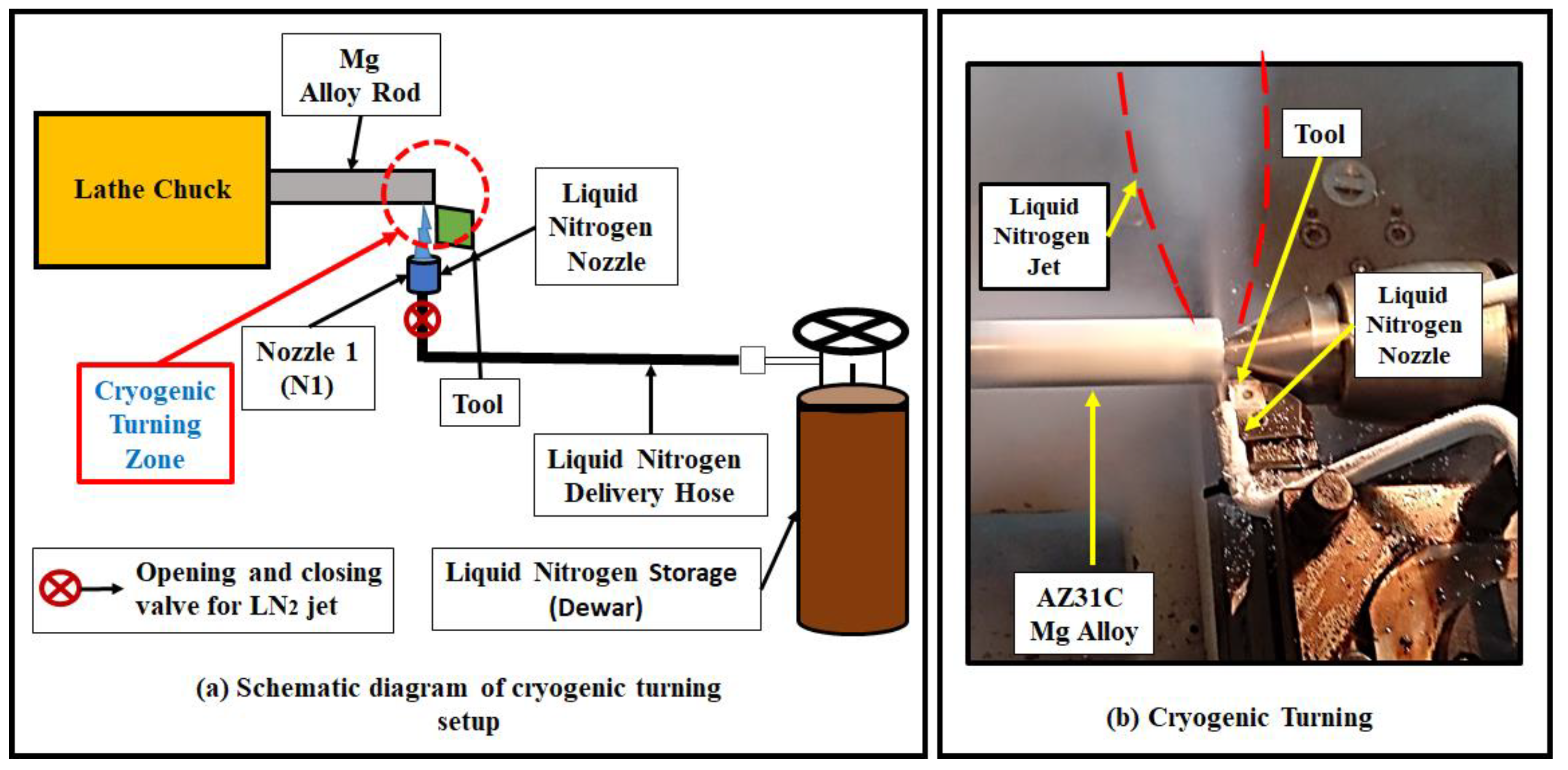
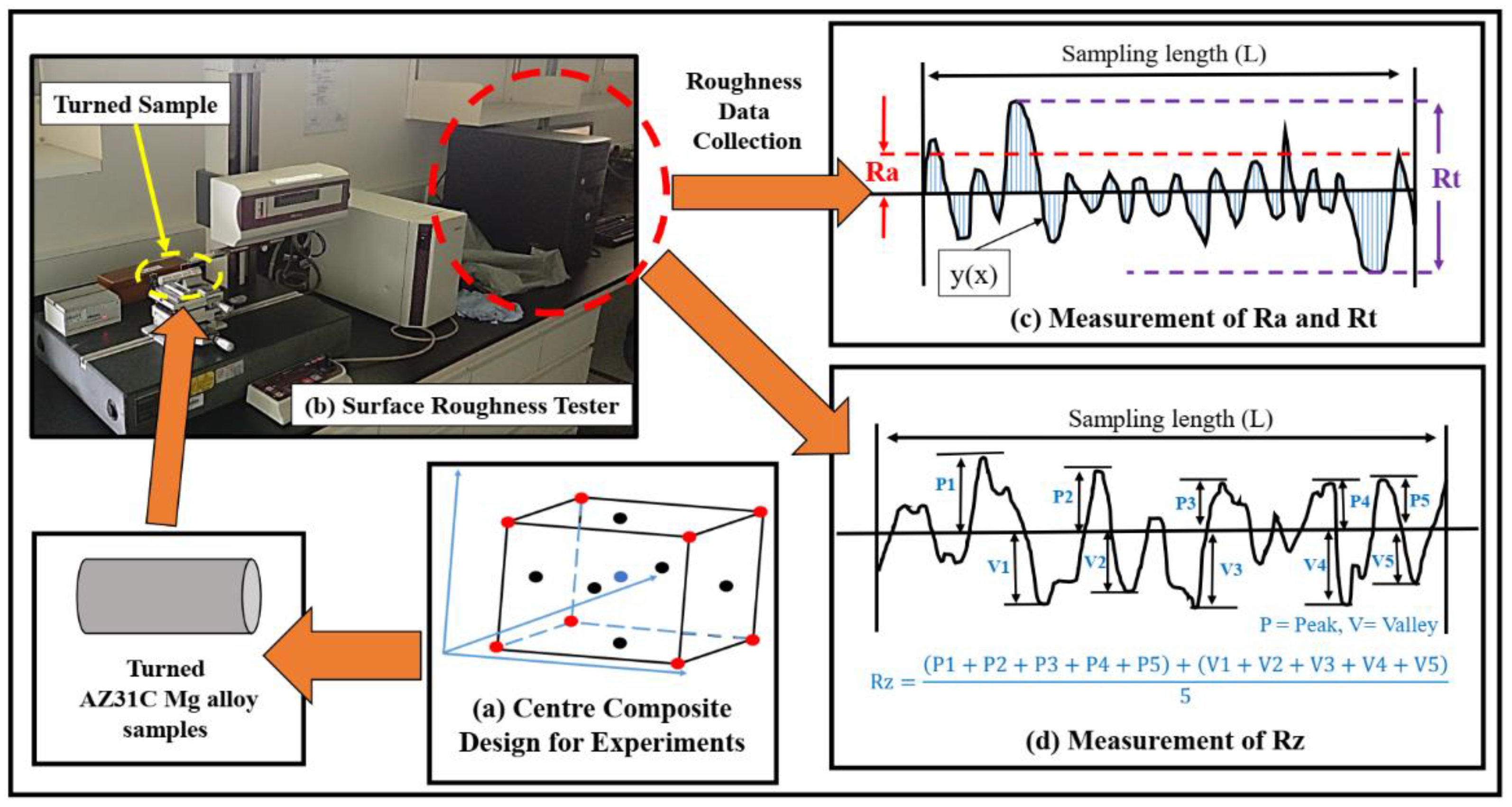
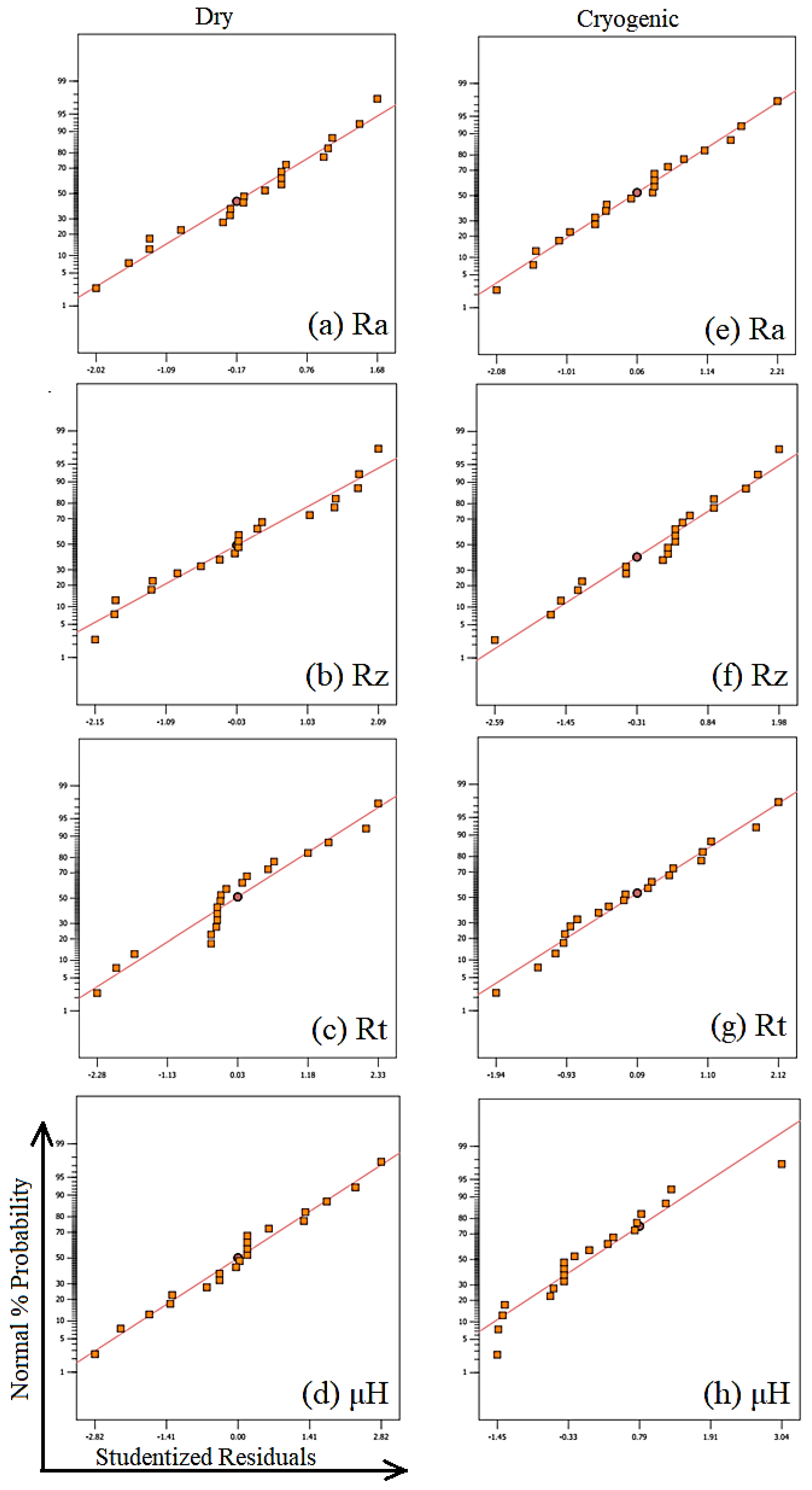
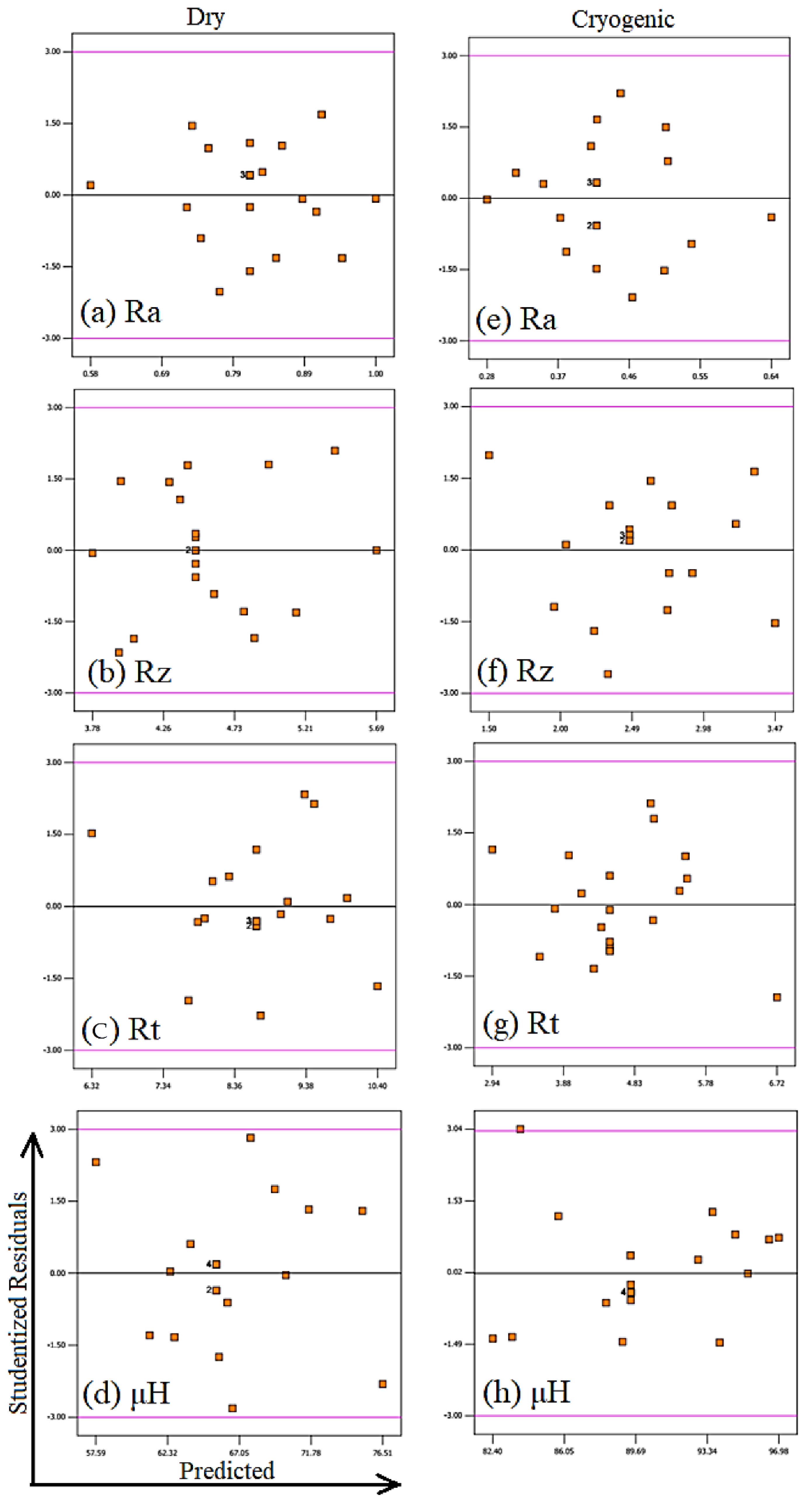
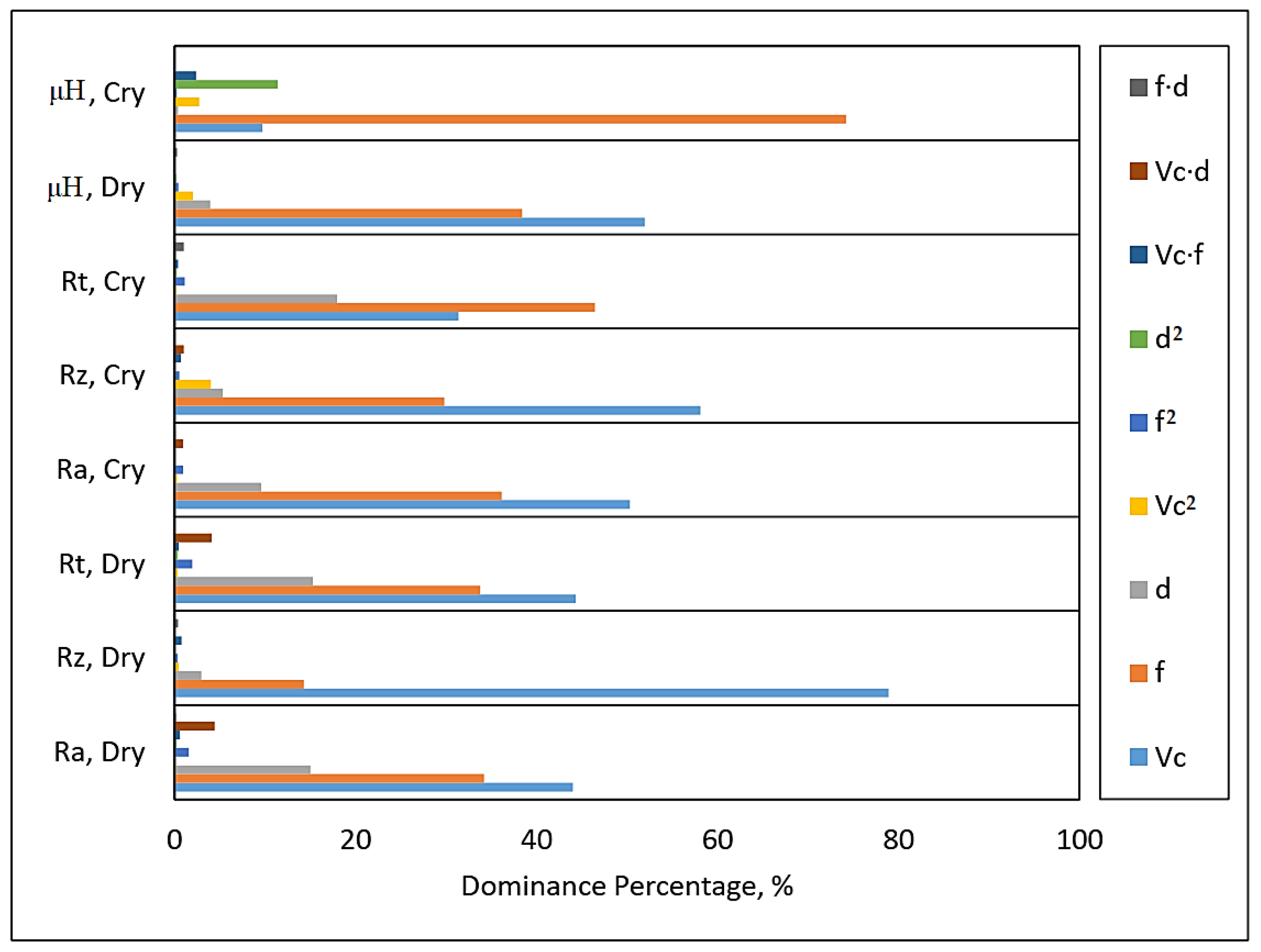
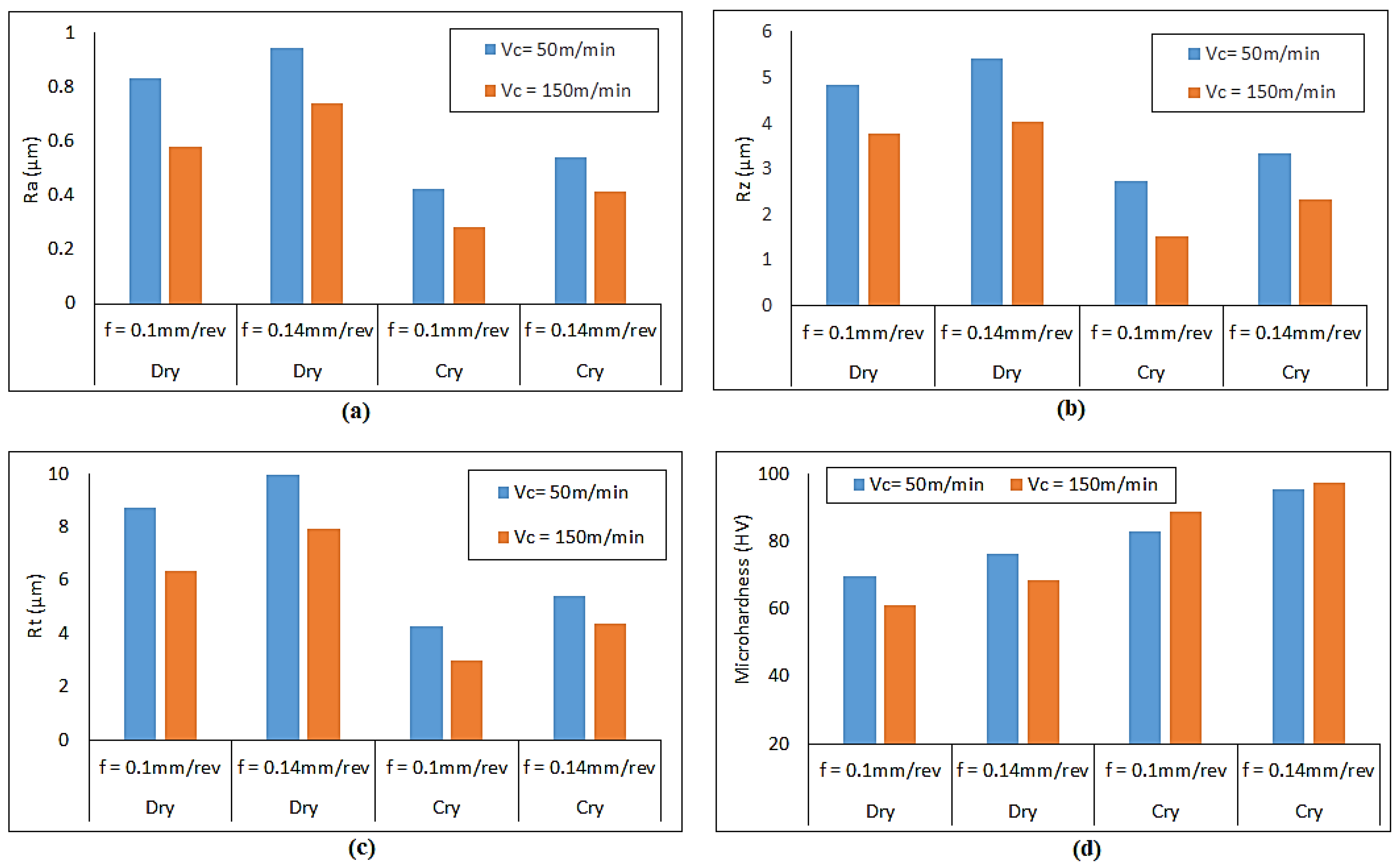
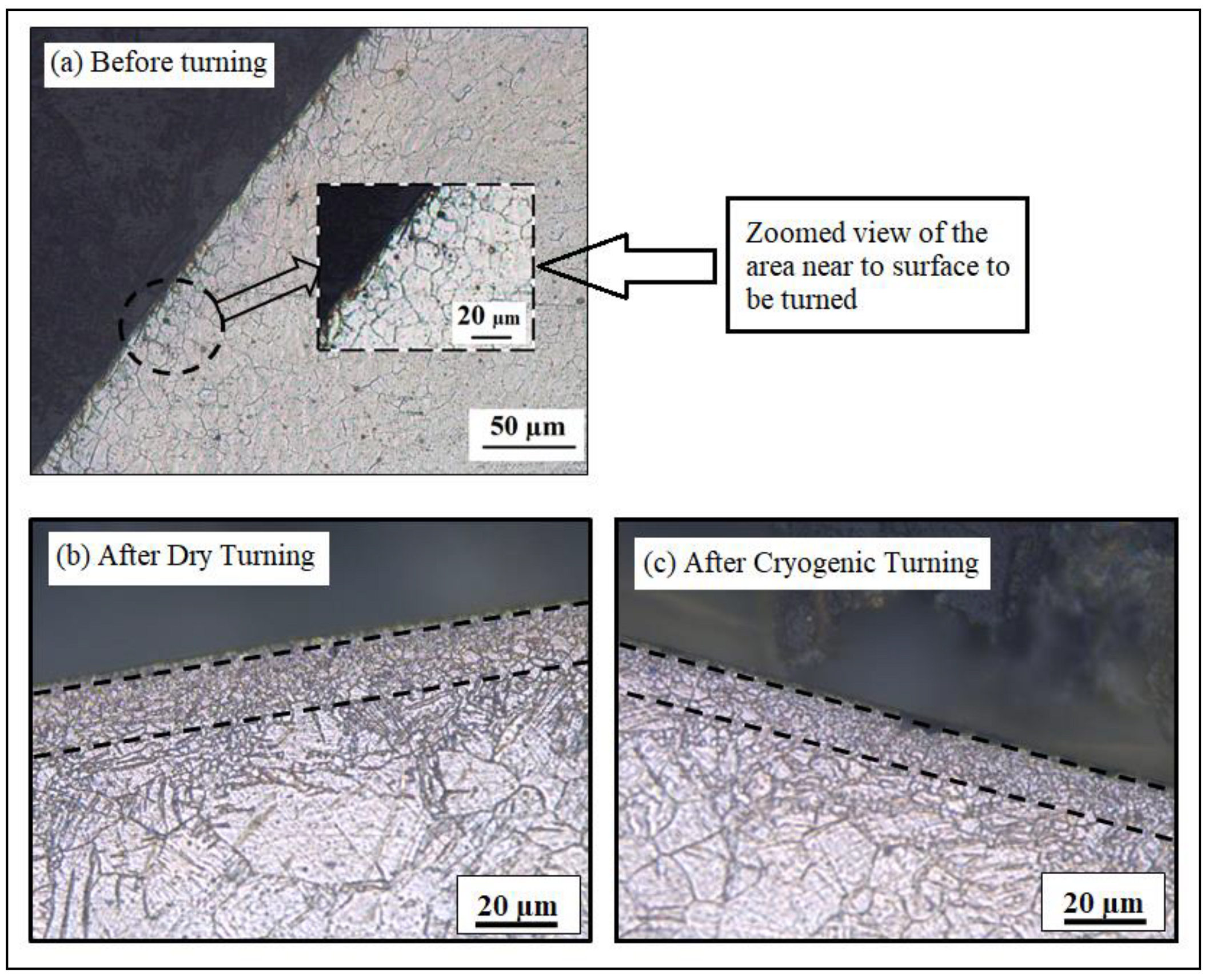
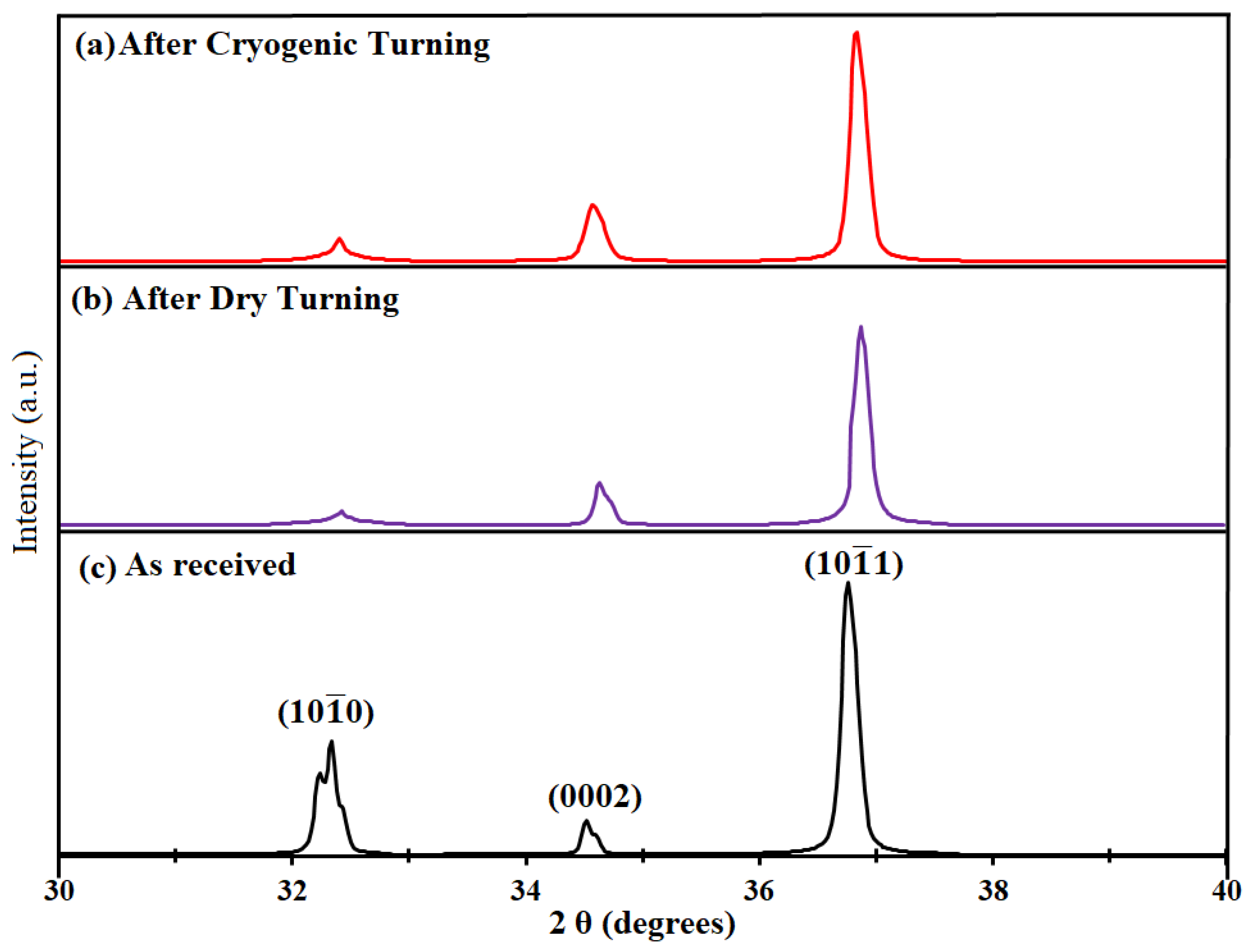
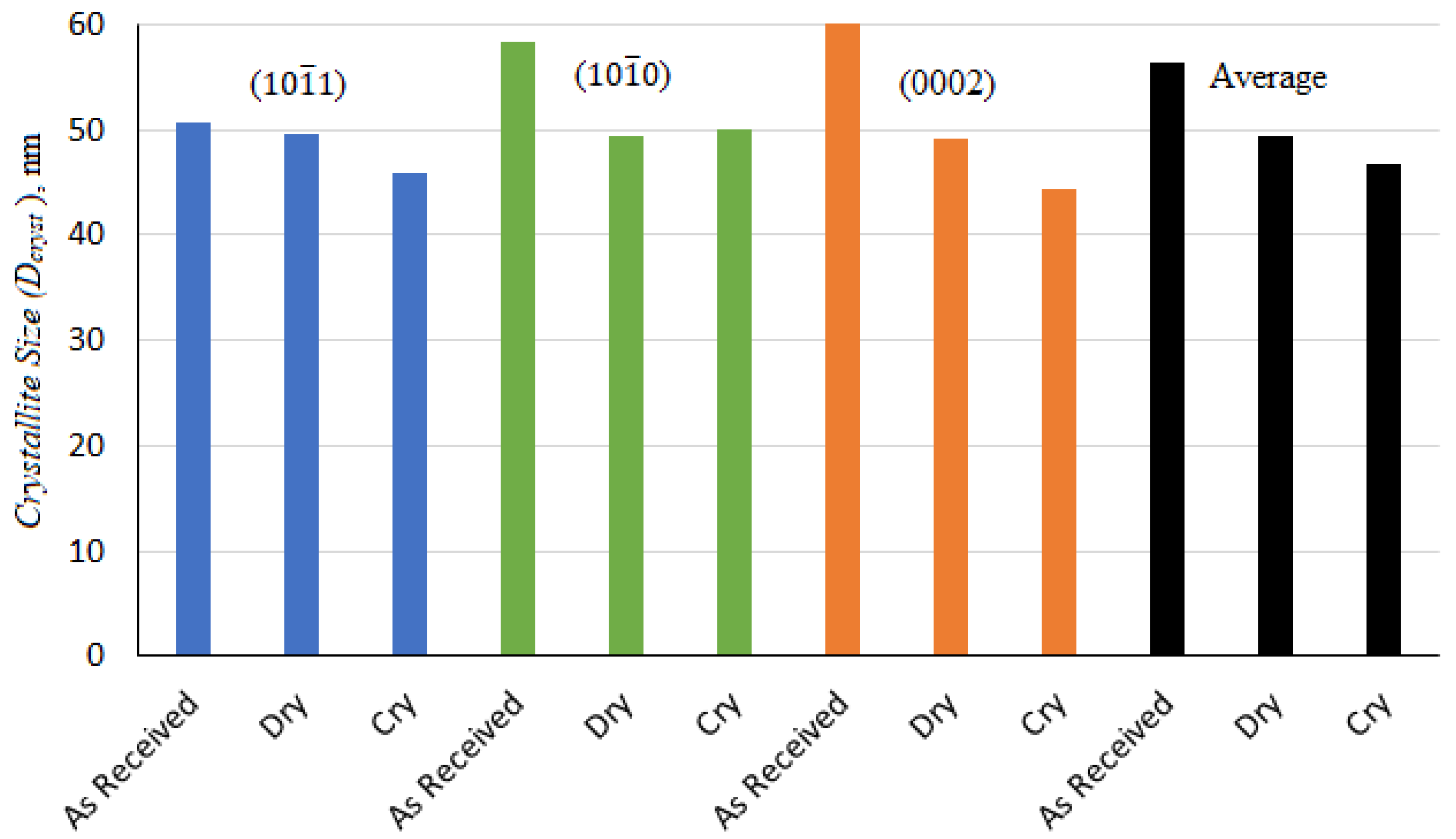
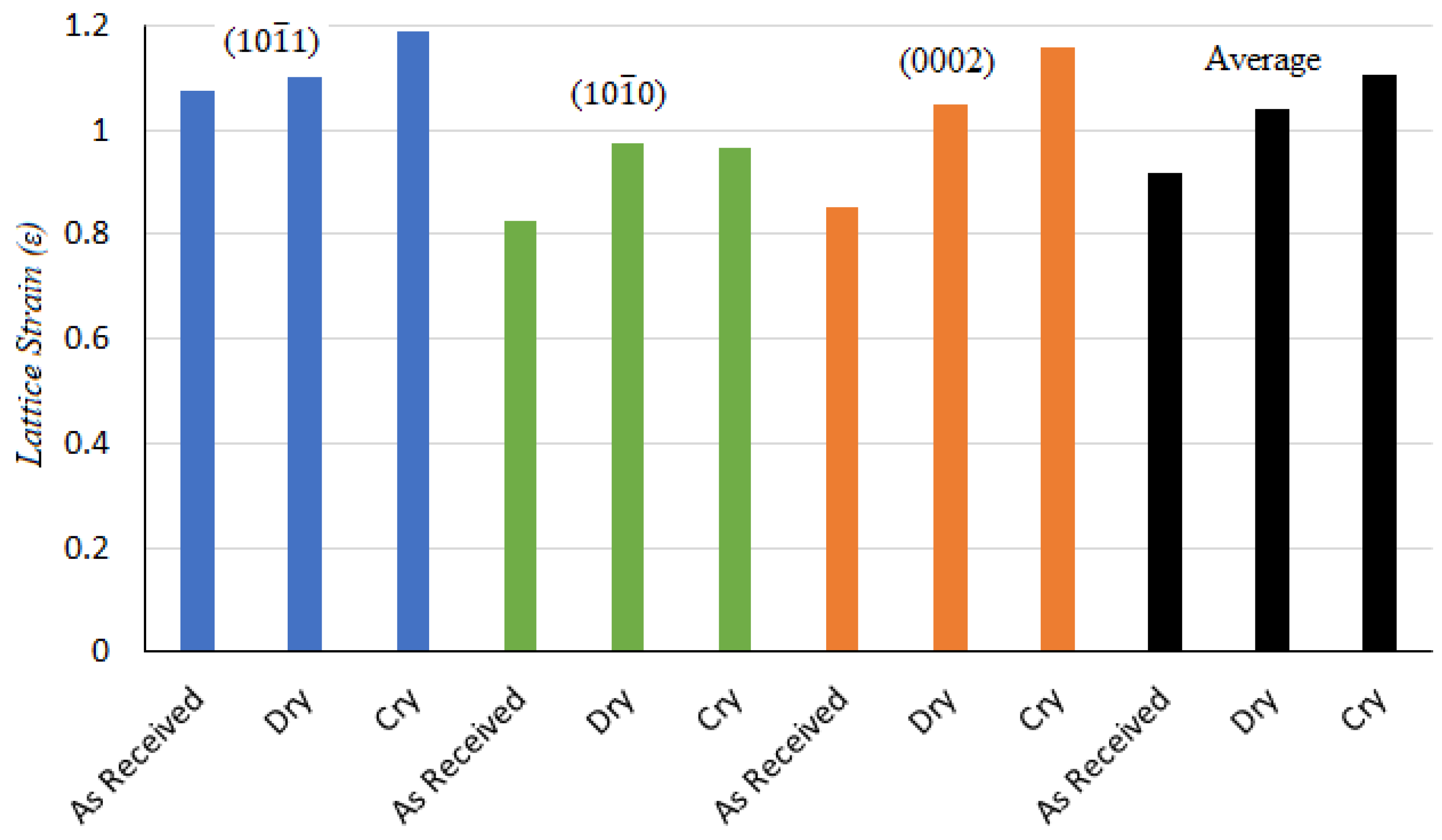
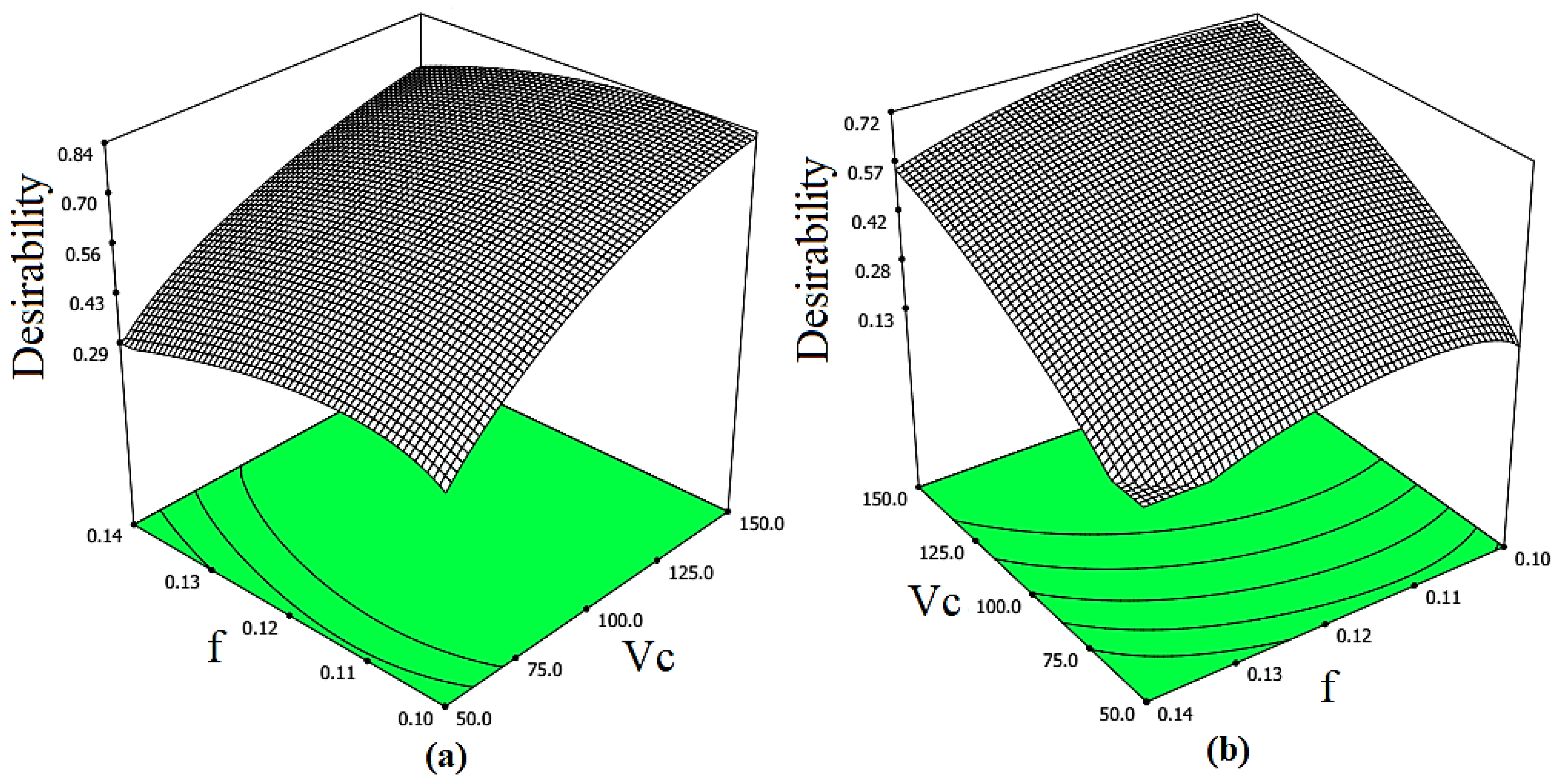
| Author/Year [Reference] | Material Removal Process | Work Material | Surface Roughness Parameters | Micro-Hardness | ||
|---|---|---|---|---|---|---|
| Ra | Rz | Rt | ||||
| Pu et al. (2012) [29] | Burnishing | AZ31B- Mg | √ | - | - | - |
| Kheireddine et al. (2013) [28] | Drilling | AZ31B-Mg | - | - | - | √ |
| Dinesh et al. (2015) [30] | Turning | ZK60 Mg | √ | - | - | √ |
| Dinesh et al. (2017) [31] | Orthogonal cutting | ZK60 Mg | √ | - | - | √ |
| Danish et al. (2017) [19] | Turning | AZ31 Mg | √ | - | - | - |
| Shen et al. (2017) [32] | Orthogonal cutting | AZ31B Mg | - | - | - | √ |
| Danish et al. (2019) [33] | Turning | AZ31C Mg | √ | - | - | √ |
| CURRENT STUDY | Turning | AZ31 Mg | √ | √ | √ | √ |
| Element | Aluminum | Zinc | Manganese | Mg |
|---|---|---|---|---|
| Weight % | 3.42 | 0.97 | 0.14 | Balance |
| Turning Parameter and Levels | Cooling Techniques | Responses | ||||
|---|---|---|---|---|---|---|
| Cutting velocity (Vc), m/min | Feed rate (f), mm/rev | Depth of cut (d), mm | 1. Dry 2. Cryogenic turning with LN2 jet | Surface roughness Ra (μm) Rz (μm) Rt (μm) | Micro-hardness μH, (Hv) | Material Removal rate MRR, (mm3/min) |
| 50 | 0.10 | 0.2 | ||||
| 100 | 0.12 | 0.4 | ||||
| 150 | 0.14 | 0.6 | ||||
| S. no. | Vc | f | d | Dry Turning | Cryogenic Turning | MRR. | ||||||
|---|---|---|---|---|---|---|---|---|---|---|---|---|
| Ra | Rz | Rt | μH | Ra | Rz | Rt | μH | |||||
| 1 | 150.00 | 0.10 | 0.20 | 0.582 | 3.781 | 6.338 | 60.9 | 0.281 | 1.513 | 2.967 | 88.6 | 3 |
| 2 | 100.00 | 0.12 | 0.40 | 0.815 | 4.473 | 8.659 | 65.4 | 0.421 | 2.472 | 4.495 | 89.1 | 4.8 |
| 3 | 100.00 | 0.12 | 0.40 | 0.815 | 4.473 | 8.662 | 65.6 | 0.421 | 2.47 | 4.456 | 89.2 | 4.8 |
| 4 | 150.00 | 0.14 | 0.20 | 0.742 | 4.046 | 7.927 | 68.3 | 0.414 | 2.334 | 4.376 | 97.2 | 4.2 |
| 5 | 100.00 | 0.12 | 0.20 | 0.755 | 4.38 | 8.056 | 66.1 | 0.381 | 2.303 | 4.133 | 94.2 | 2.4 |
| 6 | 100.00 | 0.10 | 0.40 | 0.768 | 4.312 | 8.293 | 62.5 | 0.374 | 2.033 | 3.996 | 85.2 | 4 |
| 7 | 100.00 | 0.14 | 0.40 | 0.921 | 4.783 | 9.724 | 70.1 | 0.51 | 2.72 | 5.543 | 93.3 | 5.6 |
| 8 | 150.00 | 0.12 | 0.40 | 0.722 | 3.987 | 7.656 | 62.4 | 0.353 | 2.215 | 3.768 | 89.6 | 7.2 |
| 9 | 100.00 | 0.12 | 0.60 | 0.851 | 4.587 | 9.016 | 64 | 0.453 | 2.623 | 5.156 | 93 | 7.2 |
| 10 | 100.00 | 0.12 | 0.40 | 0.816 | 4.477 | 8.662 | 65.4 | 0.419 | 2.471 | 4.461 | 89.2 | 4.8 |
| 11 | 100.00 | 0.12 | 0.40 | 0.814 | 4.469 | 8.659 | 65.6 | 0.42 | 2.471 | 4.451 | 89.2 | 4.8 |
| 12 | 50.00 | 0.10 | 0.60 | 0.862 | 4.976 | 9.118 | 66.1 | 0.506 | 2.898 | 5.067 | 82 | 3 |
| 13 | 150.00 | 0.10 | 0.60 | 0.731 | 3.944 | 7.829 | 58 | 0.318 | 1.946 | 3.543 | 88 | 9 |
| 14 | 100.00 | 0.12 | 0.40 | 0.812 | 4.478 | 8.662 | 65.6 | 0.42 | 2.47 | 4.531 | 89.2 | 4.8 |
| 15 | 50.00 | 0.12 | 0.40 | 0.891 | 5.134 | 9.414 | 72 | 0.512 | 3.201 | 5.125 | 86.3 | 2.4 |
| 16 | 50.00 | 0.14 | 0.20 | 0.948 | 5.422 | 9.973 | 76.1 | 0.541 | 3.331 | 5.434 | 95.4 | 1.4 |
| 17 | 100.00 | 0.12 | 0.40 | 0.815 | 4.465 | 8.706 | 65.6 | 0.421 | 2.471 | 4.452 | 89.3 | 4.8 |
| 18 | 150.00 | 0.14 | 0.60 | 0.911 | 4.432 | 9.527 | 65.4 | 0.465 | 2.762 | 5.541 | 96.7 | 12.6 |
| 19 | 50.00 | 0.14 | 0.60 | 0.998 | 5.687 | 10.38 | 75.4 | 0.643 | 3.46 | 6.674 | 95 | 4.2 |
| 20 | 50.00 | 0.10 | 0.20 | 0.833 | 4.855 | 8.699 | 69.7 | 0.422 | 2.738 | 4.256 | 83 | 1 |
| Dry Turning | Source | SOS | DOF | Mean Square | F-Value | p-Value |
|---|---|---|---|---|---|---|
| Ra | Model | 0.161832566 | 9 | 0.017981396 | 7125.834759 | <0.0001 |
| Vc | 0.0712336 | 1 | 0.0712336 | 28229.11285 | <0.0001 | |
| f | 0.0553536 | 1 | 0.0553536 | 21936.03891 | <0.0001 | |
| d | 0.0243049 | 1 | 0.0243049 | 9631.771593 | <0.0001 | |
| Vc2 | 0.000162278 | 1 | 0.000162278 | 64.30919571 | <0.0001 | |
| f2 | 0.002527778 | 1 | 0.002527778 | 1001.731514 | <0.0001 | |
| d2 | 0.000343841 | 1 | 0.000343841 | 136.2604701 | <0.0001 | |
| Vc·f | 0.000990125 | 1 | 0.000990125 | 392.3759344 | <0.0001 | |
| Vc·d | 0.007140125 | 1 | 0.007140125 | 2829.555075 | <0.0001 | |
| f·d | 0.000210125 | 1 | 0.000210125 | 83.27028731 | <0.0001 | |
| Residual | 13.552 | 10 | 1.355 | - | - | |
| R-Squared = 0.9998, Adj R-Squared = 0.9997 and Pred R-Squared = 0.9992 | ||||||
| Rz | Model | 4.385992 | 9 | 0.487332 | 2131.035 | <0.0001 |
| Vc | 3.462146 | 1 | 3.462146 | 15139.47 | <0.0001 | |
| f | 0.626 | 1 | 0.626 | 2737.411 | <0.0001 | |
| d | 0.130416 | 1 | 0.130416 | 570.2924 | <0.0001 | |
| Vc2 | 0.020663 | 1 | 0.020663 | 90.35539 | <0.0001 | |
| f2 | 0.01493 | 1 | 0.01493 | 65.2858 | <0.0001 | |
| d2 | 0.000258 | 1 | 0.000258 | 1.127228 | 0.3133 | |
| Vc·f | 0.034453 | 1 | 0.034453 | 150.6586 | <0.0001 | |
| Vc·d | 0.003321 | 1 | 0.003321 | 14.52281 | 0.0034 | |
| f·d | 0.016836 | 1 | 0.016836 | 73.62198 | <0.0001 | |
| Residual | 0.002287 | 10 | 0.000229 | - | - | |
| R-Squared = 0.9995, Adj R-Squared = 0.9990 and Pred R-Squared = 0.9934 | ||||||
| Rt | Model | 15.56307 | 9 | 1.72923 | 1742.162 | <0.0001 |
| Vc | 6.900625 | 1 | 6.900625 | 6952.231 | <0.0001 | |
| f | 5.262052 | 1 | 5.262052 | 5301.404 | <0.0001 | |
| d | 2.378513 | 1 | 2.378513 | 2396.301 | <0.0001 | |
| Vc2 | 0.054075 | 1 | 0.054075 | 54.47954 | <0.0001 | |
| f2 | 0.305444 | 1 | 0.305444 | 307.7287 | <0.0001 | |
| d2 | 0.053307 | 1 | 0.053307 | 53.70529 | <0.0001 | |
| Vc·f | 0.0705 | 1 | 0.0705 | 71.02736 | <0.0001 | |
| Vc·d | 0.641278 | 1 | 0.641278 | 646.0739 | <0.0001 | |
| f·d | 0.001176 | 1 | 0.001176 | 1.184921 | 0.3019 | |
| Residual | 0.009926 | 10 | 0.000993 | - | - | |
| R-Squared = 0.9993, Adj R-Squared = 0.9987 and Pred R-Squared = 0.9940 | ||||||
| Cryogenic Turning | Source | Sum of Squares | Degree of Freedom | Mean Square | F-Value | p-Value |
|---|---|---|---|---|---|---|
| Ra | Model | 0.124974 | 9 | 0.013886 | 10042.47 | <0.0001 |
| Vc | 0.062885 | 1 | 0.062885 | 45478.89 | <0.0001 | |
| f | 0.045158 | 1 | 0.045158 | 32658.93 | <0.0001 | |
| d | 0.011972 | 1 | 0.011972 | 8657.962 | <0.0001 | |
| Vc2 | 0.000358 | 1 | 0.000358 | 258.8798 | <0.0001 | |
| f2 | 0.001202 | 1 | 0.001202 | 869.4938 | <0.0001 | |
| d2 | 4.6 × 10−5 | 1 | 4.6 × 10−5 | 33.28402 | 0.0002 | |
| Vc·f | 7.2 × 10−5 | 1 | 7.2 × 10−5 | 52.07101 | <0.0001 | |
| Vc·d | 0.001201 | 1 | 0.001201 | 868.2117 | <0.0001 | |
| f·d | 0.000128 | 1 | 0.000128 | 92.57068 | <0.0001 | |
| Residual | 1.38 × 10−5 | 10 | 1.38 × 10−6 | - | - | |
| R-Squared = 0.9998, Adj R-Squared = 0.9998 and Pred R-Squared = 0.9991 | ||||||
| Rz | Model | 4.061161 | 9 | 0.45124 | 5552.296 | <0.0001 |
| Vc | 2.360016 | 1 | 2.360016 | 29038.88 | <0.0001 | |
| f | 1.210344 | 1 | 1.210344 | 14892.71 | <0.0001 | |
| d | 0.21609 | 1 | 0.21609 | 2658.885 | <0.0001 | |
| Vc2 | 0.16281 | 1 | 0.16281 | 2003.303 | <0.0001 | |
| f2 | 0.021384 | 1 | 0.021384 | 263.1211 | <0.0001 | |
| d2 | 7.78 × 10−6 | 1 | 7.78 × 10−6 | 0.09571 | 0.7634 | |
| Vc·f | 0.029041 | 1 | 0.029041 | 357.3296 | <0.0001 | |
| Vc·d | 0.040898 | 1 | 0.040898 | 503.2305 | <0.0001 | |
| f·d | 0.000162 | 1 | 0.000162 | 1.993333 | 0.1883 | |
| Residual | 0.000813 | 10 | 8.13 × 10−5 | - | - | |
| R-Squared = 0.9998, Adj R-Squared = 0.9996 and Pred R-Squared = 0.9982 | ||||||
| Rt | Model | 12.86389 | 9 | 1.429322 | 489.277 | <0.0001 |
| Vc | 4.046232 | 1 | 4.046232 | 1385.082 | <0.0001 | |
| f | 5.989212 | 1 | 5.989212 | 2050.192 | <0.0001 | |
| d | 2.318423 | 1 | 2.318423 | 793.6287 | <0.0001 | |
| Vc2 | 0.023855 | 1 | 0.023855 | 8.165749 | 0.0170 | |
| f2 | 0.145303 | 1 | 0.145303 | 49.73911 | <0.0001 | |
| d2 | 0.03024 | 1 | 0.03024 | 10.3516 | 0.0092 | |
| Vc·f | 0.04836 | 1 | 0.04836 | 16.55448 | 0.0023 | |
| Vc·d | 0.012012 | 1 | 0.012012 | 4.112048 | 0.0701 | |
| f·d | 0.129541 | 1 | 0.129541 | 44.34354 | <0.0001 | |
| Residual | 0.029213 | 10 | 0.002921 | - | - | |
| R-Squared = 0.9977, Adj R-Squared = 0.9957 and Pred R-Squared = 0.9851 | ||||||
| Micro-Hardness | Source | Sum of Squares | Degree of Freedom | Mean Square | F-Value | p-Value |
|---|---|---|---|---|---|---|
| For Dry turning | Model | 376.3987 | 9 | 41.82207 | 275.2646 | <0.0001 |
| Vc | 196.249 | 1 | 196.249 | 1291.672 | <0.0001 | |
| f | 145.161 | 1 | 145.161 | 955.4209 | <0.0001 | |
| d | 14.884 | 1 | 14.884 | 97.96353 | <0.0001 | |
| Vc2 | 7.652784 | 1 | 7.652784 | 50.3691 | <0.0001 | |
| f2 | 1.622784 | 1 | 1.622784 | 10.68084 | 0.0085 | |
| d2 | 0.638409 | 1 | 0.638409 | 4.201882 | 0.0675 | |
| Vc·f | 0.10125 | 1 | 0.10125 | 0.666407 | 0.4333 | |
| Vc·d | 0.28125 | 1 | 0.28125 | 1.851132 | 0.2035 | |
| f·d | 1.05125 | 1 | 1.05125 | 6.919119 | 0.0251 | |
| Residual | 1.519341 | 10 | 0.151934 | - | - | |
| R-Squared = 0.9960, Adj R-Squared = 0.9924 and Pred R-Squared = 0.9263 | ||||||
| For Cryogenic turning | Model | 343.6334 | 9 | 38.18149 | 92.40286 | <0.0001 |
| Vc | 33.856 | 1 | 33.856 | 81.93476 | <0.0001 | |
| f | 258.064 | 1 | 258.064 | 624.5395 | <0.0001 | |
| d | 1.369 | 1 | 1.369 | 3.313111 | 0.0987 | |
| Vc2 | 9.458182 | 1 | 9.458182 | 22.8897 | 0.0007 | |
| f2 | 0.845682 | 1 | 0.845682 | 2.046631 | 0.1830 | |
| d2 | 39.61506 | 1 | 39.61506 | 95.87222 | <0.0001 | |
| Vc·f | 8.20125 | 1 | 8.20125 | 19.84781 | 0.0012 | |
| Vc·d | 0.01125 | 1 | 0.01125 | 0.027226 | 0.8722 | |
| f·d | 0.06125 | 1 | 0.06125 | 0.148231 | 0.7083 | |
| Residual | 4.132068 | 10 | 0.413207 | - | - | |
| R-Squared = 0.9881, Adj R-Squared = 0.9774 and Pred R-Squared = 0.9192 | ||||||
| Models | Maximum Percentage Error | |
|---|---|---|
| Dry Turning | Cryogenic Turning | |
| For Ra | 0.298% | 0.409% |
| For Rz | 0.316% | 0.724% |
| For Rt | 0.557% | 1.591% |
| For μH | 0.756% | 1.634% |
| Name | Goal | Lower Limit | Upper Limit | Lower Weight | Upper Weight | Importance |
|---|---|---|---|---|---|---|
| Cutting velocity | is in range | 50 | 150 | 1 | 1 | 3 |
| Feed rate | is in range | 0.1 | 0.14 | 1 | 1 | 3 |
| Depth of cut | is in range | 0.2 | 0.6 | 1 | 1 | 3 |
| Ra, Cry | minimize | 0.281 | 0.643 | 1 | 1 | 3 |
| Rz, Cry | minimize | 1.513 | 3.46 | 1 | 1 | 3 |
| Rt, Cry | minimize | 2.967 | 6.674 | 1 | 1 | 3 |
| μH, Cry | maximize | 82 | 97.2 | 1 | 1 | 3 |
| MMR, Cry | maximize | 1 | 12.6 | 1 | 1 | 3 |
| Process Parameters/Responses | Optimal Solution | |
|---|---|---|
| Case 1 | Case 2 | |
| Vc (m/min) | 150 | 150 |
| f (mm/rev) | 0.11 | 0.11 |
| d (mm) | 0.2 | 0.6 |
| Ra (μm) | 0.292 | 0.332 |
| Rz (μm) | 1.707 | 2.153 |
| Rt (μm) | 3.065 | 3.793 |
| μH (HV) | 90.79 | 90.8 |
| MMR (mm3/min) | 3.3 | 9.9 |
| Desirability | 0.837 | 0.71 |
Publisher’s Note: MDPI stays neutral with regard to jurisdictional claims in published maps and institutional affiliations. |
© 2021 by the authors. Licensee MDPI, Basel, Switzerland. This article is an open access article distributed under the terms and conditions of the Creative Commons Attribution (CC BY) license (https://creativecommons.org/licenses/by/4.0/).
Share and Cite
Danish, M.; Rubaiee, S.; Ijaz, H. Predictive Modelling and Multi-Objective Optimization of Surface Integrity Parameters in Sustainable Machining Processes of Magnesium Alloy. Materials 2021, 14, 3547. https://doi.org/10.3390/ma14133547
Danish M, Rubaiee S, Ijaz H. Predictive Modelling and Multi-Objective Optimization of Surface Integrity Parameters in Sustainable Machining Processes of Magnesium Alloy. Materials. 2021; 14(13):3547. https://doi.org/10.3390/ma14133547
Chicago/Turabian StyleDanish, Mohd, Saeed Rubaiee, and Hassan Ijaz. 2021. "Predictive Modelling and Multi-Objective Optimization of Surface Integrity Parameters in Sustainable Machining Processes of Magnesium Alloy" Materials 14, no. 13: 3547. https://doi.org/10.3390/ma14133547






